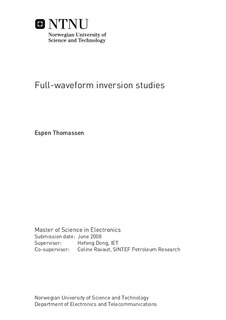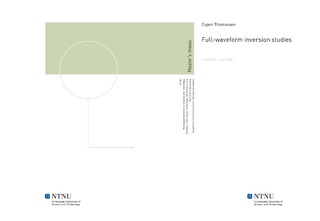| dc.description.abstract | In this master thesis, full-waveform inversion (FWI) was applied to a synthetic, and very complex, geological structure containing a salt body. The main objective was to evaluate the capabilities of FWI to estimate velocities in this context, and more specially below the salt. Seismic depth imaging is now the preferred seismic imaging tool for today's most challenging exploration projects. Seismic depth imaging problem usually requires the definition of a smooth background velocity model before determining the short wavelength component of the structure by pre-stack depth migration. It is well established that success of pre-stack depth migration in complex geological media strongly depends from the definition of the background velocity model. Standard tools for building velocity models generally fail to reconstruct the correct sub-salt velocities. Sub-salt imaging is a very challenging problem and a lot of resources are spent trying to solve this problem, since salt bodies in the sub-surface are known to be very good hydrocarbon traps. In this master thesis, the work have been performed on a modified version of the 2004 BP velocity benchmark model. This model represents a very interesting salt context, where conventional imaging methods can not provide any good results. After describing the seismic inversion problem, and the FWI theory and code used in this work, the application to the 2004 BP benchmark model is described. FWI was first applied to the synthetic data using a starting model derived by smoothing the true velocity model. This is an easy way to ensure an adequate starting model, as the method is very dependent on a good starting model. In the inversion process 17 frequency components were used, ranging between 1 and 15 Hz. This resulted in a velocity model that accurately recovered both the salt body and the sub-salt velocities. The average deviation between the true and estimated sub-salt velocities was found to be approximately 6 %. A more realistic starting model was then derived using first-arrival traveltime tomography, a well known method for obtaining velocity models. FWI was applied to this starting model, and the result was also positive when using this starting model. The salt body was well delineated, whereas the sub-salt velocities were generally more inaccurate than for the previous application. The sub-salt velocity difference was increased to roughly 10 %. However, if more effort had been spent on reconstructing a more accurate starting model, the results might have improved. When fewer frequency components are used in the inversion, the result declined. A test using only 6 frequency components showed that the final reconstructed model suffered from a lack of recovered wavenumbers, especially at the deeper and more complex parts of the model. In such a complex medium as the 2004 BP benchmark model, it is hence necessary to introduce wavenumbers by including a sufficient number of frequency components in the inversion process. Other tests that were conducted showed that, in this particular case, the non-linearity of the inversion problem increased with higher frequencies, and was reduced by larger offset ranges included in the seismic data. The inversion is hence sensitive to the starting frequency as well as the starting model. The results in this master thesis demonstrate that FWI has a great potential in reconstructing sub-salt velocities in salt media. For the future, both applying the method to real data from a salt basin area, and develop a migration tool and test the effect of FWI on a migrated image, are interesting challenges. | nb_NO |

